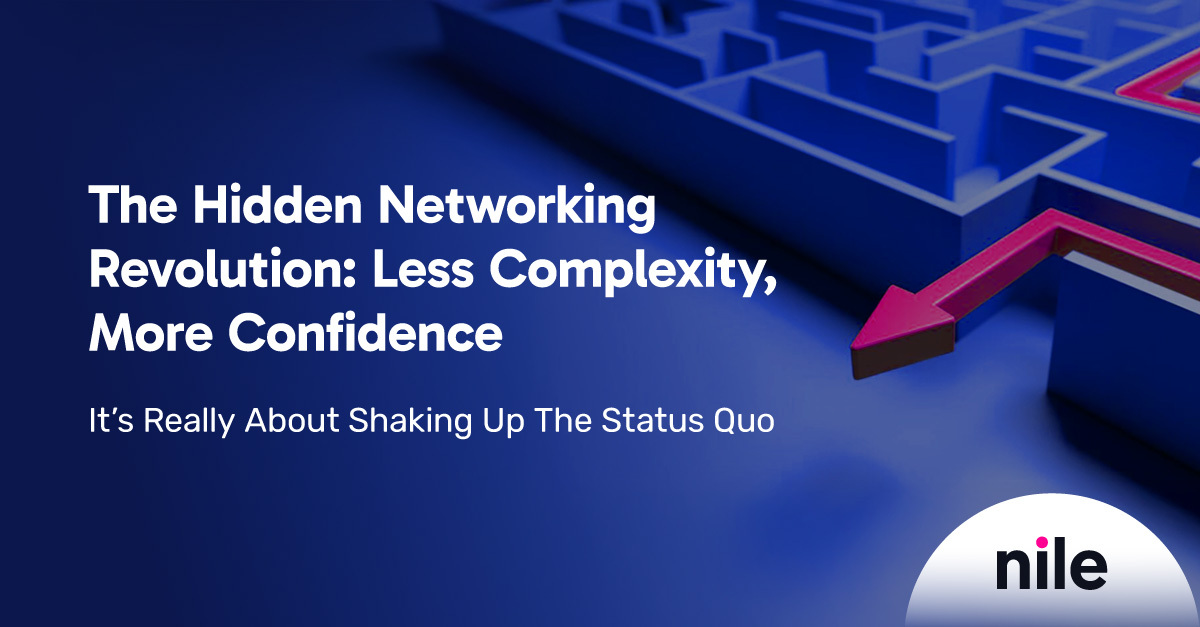Share Via
Nile is recognized as a Challenger in the 2025 Gartner® Magic Quadrant™ for Infrastructure Platform Consumption Services
Enterprise infrastructure is entering an era defined by how networks are consumed, not just how they’re built. When Gartner® released its inaugural Magic Quadrant™ for Infrastructure Platform Consumption Services (IPCS), we believe that message stood out—and we think it captures the foundation of Nile’s approach.
This shift, in our opinion, aligns directly with Nile’s mission to deliver a secure, autonomous, and outcome-driven enterprise LAN through an AI-powered Network-as-a-Service (NaaS) model. In our opinion, being recognized as a Challenger in this new Magic Quadrant reinforces our belief that organizations increasingly prefer predictable outcomes delivered through a service model rather than buying and managing infrastructure, support contracts, and additional IT resources on their own.
For us, Nile’s recognition isn’t just a validation; it’s a reflection of where enterprise networking is heading. The 30+ year old model of building and maintaining infrastructure is giving way to one focused on experiences, outcomes, and intelligence. This new as-a-service model offers:
- A simplified operational structure
- Zero Trust security without added complexity
- Reliable performance that’s both measurable and guaranteed
The future will favor organizations that simplify operations, embed security into every connection, and drive performance through automation and accountability. That’s the standard we’ve built Nile around, and it’s the mindset we continue to challenge the market with. This evolution is reshaping not just how an enterprise LAN is managed, but also how IT teams design and operate networks and how security is enforced across every connection.
A New Model that Enhances IT Teams
The IT landscape is evolving faster than legacy networks can keep up. Today’s teams are stretched thin—supporting thousands of devices, managing hybrid environments, and constantly putting out fires across complex infrastructures. Whether a staff of two or twenty, few ever say they have time to focus on anything beyond keeping the lights on.
Nile’s AI-powered NaaS solves this problem by bringing together enterprise-grade hardware, software, AI, automation, and autonomous operations under one roof, allowing the network to detect and resolve issues on its own. By shifting routine maintenance and problem-solving to the network itself, Nile changes the role of IT entirely. IT teams are involved in defining who and what can connect to the network—not stuck in the constant cycle of responding to help desk tickets or manually adjusting default configurations. Instead, they gain the freedom to focus on strategy rather than day-to-day operations.
The Legacy Network Model Has Led to Complexity and Time Loss
Traditional enterprise networks aren’t designed for today’s demands. They commonly include layers of controllers, gateways, overlays, and security appliances, creating an environment that’s difficult to manage and even harder to secure. Each new tool added to solve one problem often introduces two more.
At Nile, we see the real opportunity not in simply delivering networking “as a service,” but in standardizing it around a modern, unified architecture. Every Nile deployment runs on the same Zero Trust Fabric—consistent across every site, business type, and environment, so performance and security are never left to chance.
This consistency enables three core outcomes:
- Built-in resilience: A standardized architecture ensures that every network instance benefits from the same level of reliability and protection
- Predictable performance: AI-powered automation delivers deterministic results as fewer variables mean fewer errors—and a network that continuously improves without manual intervention
- Effortless evolution: Patches, upgrades, and new features are delivered efficiently, automatically, and uniformly, with no downtime or reconfiguration cycles
That’s how Nile eliminates the complexity and time loss that have come to define legacy enterprise networks—and replaces them with a model built for intelligence, security, and speed.
Enterprise LAN Security Shouldn’t Be Built on Legacy Practices
As malware and AI-driven threats evolve, security can’t be a checklist of add-on systems built to patch old vulnerabilities. It needs to be woven into the network itself. That’s where Nile’s approach stands apart: every deployment is built on a consistent, unified Zero Trust Fabric that protects every connection by default.
- Every device is isolated from the moment it connects to the network
- All traffic is continuously monitored and governed by identity-based policies
- Legacy constructs like VLANs, dACLs, and complex EVPN/VxLANs are no longer required
This built-in protection replaces the need for separate security layers, giving organizations confidence that their users and data are protected from the moment they connect.
Outcomes, Not Overhead
Traditional infrastructure models required organizations to buy, build, and maintain every piece of the network themselves. This facilitated unpredictable costs, complexity, and risk with each upgrade. Nile challenges this model by delivering outcomes without the operational burden.
At the core of this approach are AI-powered lifecycle operations that automate everything from design and deployment to continuous optimization. Each Nile NaaS deployment monitors its own performance, detects anomalies, and resolves issues before users are affected—ensuring predictable outcomes every day.
This consistency creates value that traditional network architectures—where no two networks are alike—simply can’t match. Combined with financially backed SLAs tied to user experience rather than uptime, Nile unites hardware, software, operations, and support into a single predictable subscription—often achieving 30–50% operational efficiency gains over legacy methods.
Our Mindset We believe the Gartner® Magic Quadrant™ for Infrastructure Platform Consumption Services reflects a broader industry transformation: one driven by automation, standardization, and measurable results.
To us, being named a Challenger validates that transformation and affirms the path we’ve taken. It’s proof that simplicity and security don’t have to be at odds—and that networks can deliver exceptional experiences, without the cost, complexity, and constant need to jump into another refresh cycle.
The era of managed complexity is ending. The era of measurable outcomes is here.
To explore the full findings, we’re offering complimentary access to the 2025 Gartner® Magic Quadrant™ for Infrastructure Platform Consumption Services (IPCS).
Gartner does not endorse any vendor, product or service depicted in its research publications and does not advise technology users to select only those vendors with the highest ratings or other designation. Gartner research publications consist of the opinions of Gartner’s research organization and should not be construed as statements of fact. Gartner disclaims all warranties, expressed or implied, with respect to this research, including any warranties of merchantability or fitness for a particular purpose.
GARTNER is a registered trademark and service mark of Gartner and Magic Quadrant is a registered trademark of Gartner, Inc. and/or its affiliates in the U.S. and internationally and are used herein with permission. All rights reserved.



